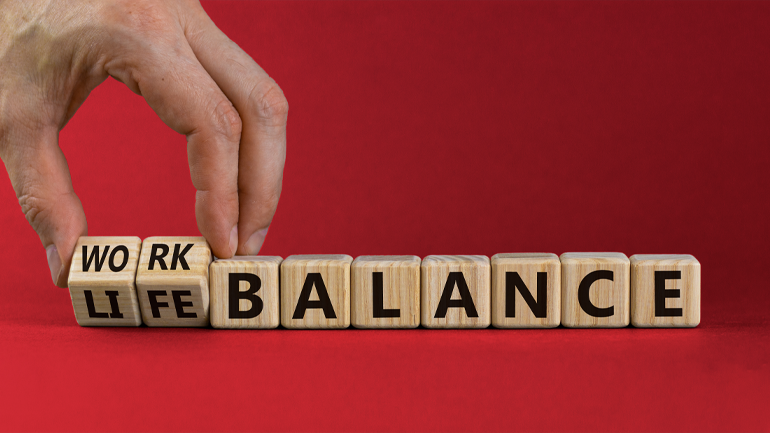Working from home is the new normal, as most of society has recently discovered. However, as this new routine has set in, the problem of achieving a proper work–life balance has also barged through the door. The abrupt transition to remote work has obscured the physical and psychological barrier that existed between home and the workplace.
At first, the opportunity for the workers to work from home was seen as a positive aspect that promotes work-life balance. However, unfavorable indications emerged over time, since family and professional commitments sometimes tug employees in opposite directions.
What is work–life balance?
So, what exactly is work-life balance? Things can get a little tricky here. The balance of work-life implies something a bit different to everyone.
Generally, the work-life balance concept is used to describe how employees allocate their time between professional and personal commitments. The work–life balance includes not just equal working-life allocation, but also encompasses flexibility and balance when working in a professional area, while retaining the energy and time to spend on one’s personal life, such as family, friends, hobbies or social events.
Work-life balance is an important aspect of a healthy work environment. The capacity to successfully balance a job, family duties and a personal life is critical for an individual. Poor work-life balance may be detrimental to an employee’s health and happiness, whereby they become more anxious and feel less in control both at work and at home.
Work from home effects on work–life balance
Many people in the workforce have had epiphanies as a result of their increased freedom and flexibility due to working from the comfort of their homes. Working from home has several obvious advantages, such as the elimination of travel time, a greater flexibility of work hours and the freedom to scavenge the refrigerator during lunch. However, there are negative aspects to remote work as well.
With fewer physical and emotional boundaries between personal and work life, the delicate equilibrium of work-life balance is disrupted.
As a result of not having to travel to work, remote employees have gained time. But what do they do with this commodity? Simple, they do more work. Additionally, the apprehension of being monitored by employers has led to individuals working harder for longer periods of time. With these changes, comes another possible drawback: exhaustion. Add to that the seclusion of not physically seeing coworkers and not being able to work face-to-face, anxiety and tension may accumulate before realization hits.
Improving the work-life equilibrium
If you are a remote worker who is finding the boundary between work and life becoming increasingly blurred, it is time to make some adjustments. Here are some suggestions for promoting a healthy work-life balance when your office is your own home.
Do not rush to begin your workday
Logging into your work computer first thing in the morning, or worse, dragging it into bed with you, is an unhealthy habit. And, if you begin your day at 7 a.m., you will have completed a 10-hour shift by 5 p.m. If you do this every day, you will rapidly become exhausted. Each day, before you even consider turning on your computer, go through a morning routine. Eat breakfast, sip on a cup of coffee, and settle down for a few minutes before your colleagues start shooting inquiries at you.
Set a schedule and stick to it
Creating and adhering to a regular routine will help you maintain productivity while also relieving some of the stress that comes with working constantly. Set your work hours and log out at the end of your regular workday to free up your time for other activities. By doing this, your team will know when they can and cannot contact you, and you will be able to arrange personal activities outside of work during your day.
Create a dedicated workspace
Having a designated workplace without too many distractions is often useful since it creates a bit of a divide between work and life at home. A separate workstation is also beneficial since it allows you to unplug when your job is done. This does not imply that you must have a home office. The mental walls that you construct in your head are more essential than the physical ones and you can simply designate a section in a room as a “work only” zone.
Get some fresh air
Get up and go outside, even if it is only for five minutes. You may stand up, stretch and get a small amount of Vitamin D. Also, while we all know that getting some fresh air in the middle of a workday feels wonderful, did you realize that it may also increase your productivity? Fresh air contributes to better decision making and information processing, and it is an excellent method for boosting your overall health.
Take a proper lunch break
Try not to work too close to the refrigerator and constantly nibbling on snacks. As wonderful as this is, it is not necessarily conducive to productivity or a feeling of work–life balance. By reserving lunchtime for yourself, you will be able to take a good break from work to fuel and replenish for the remainder of the day.
Final thoughts
Working at home is full of advantages if done correctly. The ability to maintain a healthy balance between work and other aspects of your life is a valuable life skill. Finding this equilibrium will sustain you through times of difficulty and allow you to be completely present during times of well-being. So, stand back and evaluate your personal work-life balance. Is everything in order? Or are there some constructive measures you can take to move things in the right direction?







